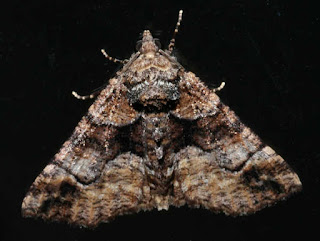Wednesday, 26 October 2016
The moth on the right hand side of the photo above, and shown below, was not noticed at the time the photo was taken. Although the photo is far from focused on the right hand moth, it is worth including because the only references I could find for the collection points of the museum samples are all in the far north of Australia. Much further north and more tropical than Toowoomba.
Family:- PYRALIDAE
Wednesday, 19 October 2016
ENNOMINAE GEOMETRIDAE
Gastrina cristaria NACOPHORINI ENNOMINAE GEOMETRIDAE
 Family:- GEOMETRIDAE
Family:- GEOMETRIDAESub Family:- ENNOMINAE
Genus:- Gastrina
Species:- cristaria
*************************************************************************************
Eumelea rosalia OENOCHROMINAE GEOMETRIDAE
Family:- GEOMETRIDAE
Sub Family:- OENOCHROMINAE
Genus:- Eumelea
Species:- rosalia
Bright orange moths are something of a rarity around here although they can be quite variable. It doesn't look like very good camouflage.
According to Moths of Australia (IBF Common) it is not closely related to other Australian moths.
There are three species in Australia, two of which also occur in countries to our North.
***********************************************************************************
Wednesday, 12 October 2016
LARENTIINAE GEOMETRIDAE
Chloroclystis cissocosma LARENTIINAE GEOMETRIDAE
 Family:- GEOMETRIDAE
Family:- GEOMETRIDAESub Family:- LARENTIINAE
Genus:- Chloroclystis
Species:- cissocosma
These moths are quite small and prefer to hide in the shadows and often go un-noticed.
Museum specimens lose their green colouring and become a grey brown.
************************************************************************************
GEOMETRIDAE GEOMETRINAE Possibly Prasinocyma semicrocea
Family:- GEOMETRIDAE
Sub Family:- GEOMETRINAE
Genus:- Prasinocyma (Possibly)
Species:- semicrocea (Possibly)
I am not certain of the identification of the genus and species. This is an older moth and some of the wing markings may have been lost.
*********************************************************************************
Wednesday, 5 October 2016
Un-identified GELECHIOIDEA moth
This moth was photographed about a year ago. I have been unable to identify it. It is quite small, probably less than 8mm long in the body. The wings are fairly short and rounded. The labial palpae are prominent, upturned, and look quite sharp. This alone should generally put it in the superfamily Gelechioidea.This moth has now been identified as Petalanthes hexastera OECOPHORINAE OECOPHORIDAE.
Also see Apr 26 17 re-visting Gelecioidea for the identification of this moth.
 Super Family:- GELECHIOIDEA
Super Family:- GELECHIOIDEAFamily:- not known, possibly HYPERTROPHIDAE
Sub Family:- not known
Genus:- not known
Species:- not known
The main families from Australia are listed below, and the closest I can get are some moths in Hypertrophidae. Even there, I could not find a good match, just some similarity in the forward wing pattern. The rear wing patterns in most cases are dull grey where the moth shown has distinctive markings.
COSMOPTERIGIDAE, DEPRESSARIIDAE, ELACHISTIDAE, ETHMIIDAE, GELECHIIDAE
HYPERTROPHIDAE, LECITHOCERIDAE, OECOPHORIDAE, SCYTHRIDIDAE
SYMMOCIDAE, XYLORYCTIDAE
Having searched many hundreds if not thousands of photos over the last year, it is time to put it in the too hard basket, in the hope that someone can perhaps come up with a name, genus, tribe or even a definite sub family.
If anyone reading this blog is able to shed any light on the identity of the moth please email me. The address is in the column to the right of the blog articles.
************************************************************************************
Subscribe to:
Comments (Atom)









